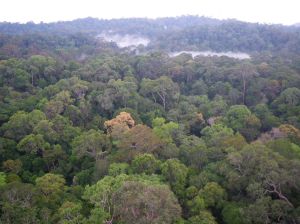Updated: 30/01/2025
This is our first collaboration study between a population geneticist, Hideki Innan, and a field-based tropical ecologist, me, Yayoi Takeuchi.
I have been long wondering why Hubbell’s neutral model fitted so well to tropical forest communities because my impression of the tropical forest was the opposite. When I was doing my postdoctoral work in Hideki’s lab, he got interested in this issue because Hubbell’s model is based on the theory of population genetics. As such we started working together on this topic, and I found that population genetics holds sophisticated and well-established theories and methodologies, which could be well applied to community ecology. We believe that incorporating those techniques will provide breakthrough insights to elucidate mechanisms shaping complex natural communities.

A species-rich tropical rain forest in Lambir Hills National Park in Sarawak, Malaysia. Photo by Yayoi Takeuchi
The study “Evaluating the performance of neutrality tests of a local community using a niche-structured simulation model” summarized:
Is your favorite local community really neutral? —- It might be “No”! Here, we found that two common methods to test Hubbell’s neutral model were not robust enough to reject neutrality.
Hubbell’s neutral model provides a good fit to the data from wide range of natural communities including tropical forests and coral reefs. There are two parameters in his model that are usually unknown and commonly estimated from the data to be tested. Two common methods to test Hubbell’s neutral model, the SAD-fitting approach and re-sampling approach, use these estimated parameters. To examine the performance of these tests, we developed a simple niche model which incorporates stochastic demography, and these two tests were applied to a simulated non-neutral data with niche-structured community. Our results suggested that these tests had relatively poor power to reject neutrality, simply due to overfitting of the neutral model with unrealistic estimated parameters. We also discussed how we could improve the performance in this paper.
